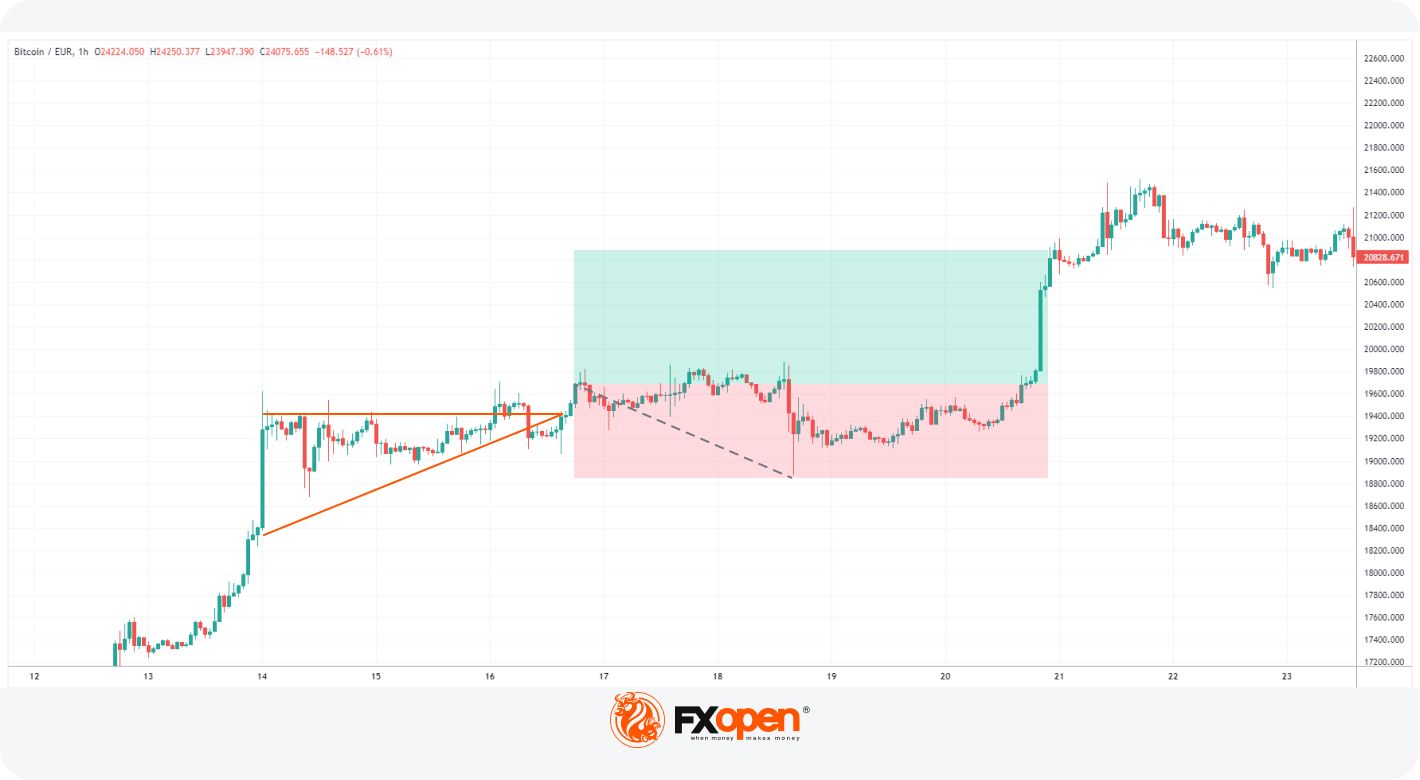FXOpen

The triangle chart patterns are significant technical analysis formations that often occur in financial markets. They are continuation patterns, indicating that the price is likely to continue its existing trend after a period of consolidation. The key advantage of these formations is that you can find them in any market. Thus, you can trade a triangle stock pattern, a triangle forex pattern, and a triangle commodity pattern. In this FXOpen article, we will learn more about the three types of triangles, including their unique characteristics, implications, and trading rules.
Ascending Triangle
The ascending triangle is a bullish pattern that forms when there is a clear upward trend in the price of an asset and signals a trend continuation. If you find an ascending triangle in a downtrend, it may provide a reversal signal. However, in most cases, it serves as a bullish continuation signal. It consists of two main components:
1.Horizontal Resistance Line: This is a flat, horizontal line that acts as a barrier, preventing the price from rising further. It is typically drawn at the price level at which sellers repeatedly push the price down, creating a ceiling.
2. Ascending Support Line: The ascending support line is a rising trendline that connects a series of higher lows, indicating that buyers are willing to step in at progressively higher prices. This upward-sloping line represents a floor for the price.
Characteristics and Implications for Traders
The ascending triangle pattern possesses several key characteristics:
- Consolidation Phase: The pattern forms during a consolidation phase when the price moves within the boundaries of the horizontal resistance and ascending support lines. This consolidation suggests a temporary pause in the prevailing uptrend.
- Decreasing Volatility: As the price oscillates between the support and resistance lines, volatility typically decreases. This reduction in price swings can be observed through diminishing candlestick ranges.
- Bullish Bias: The ascending triangle provides a bullish signal, as it implies that buyers are becoming increasingly dominant in the market. The higher lows on the support line signify growing demand.
- Breakout Anticipation: Traders watch for a breakout, which occurs when the price breaches the horizontal resistance line. This breakout is seen as confirmation that the uptrend is set to continue.
- Volume Confirmation: To validate the pattern, traders often look for an increase in trading volume as the price approaches the apex of the triangle. A surge in volume during the breakout adds credibility to the formation.
How to Trade Ascending Triangles
As with all chart patterns, the ascending triangle has particular trading rules.
- Entry Point: Traders usually wait for a breakout above the horizontal resistance line. This is considered a bullish signal, indicating that buyers have overcome the selling pressure and are likely to push the price higher.
- Confirmation Signals: To confirm the triangle, traders can use candlestick patterns or technical indicators, such as volumes or oscillators like the Stochastic RSI or MACD.
- Risk Management: To potentially limit losses, traders set a stop-loss order just below the ascending support line. The theory states that the price should move up the distance equal to the highest part of the triangle. Therefore, traders usually determine a reasonable take-profit level based on the triangle’s high.

A trader initiates a long position at the closing price of the candle that follows the breakout of an ascending triangle pattern. They set a stop-loss order just below the support level and establish a take-profit level equivalent to the pattern's height.
Descending Triangle
The descending triangle, also known as a falling triangle pattern, is a bearish continuation formation. Like the ascending triangle, it consists of two lines:
1. Horizontal Support Line: The setup features a horizontal support line drawn at a consistent price level, where buyers have consistently stepped in to prevent further price declines. This horizontal line forms the base of the triangle.
2. Descending Resistance Line: The descending resistance line, often forming a downward-sloping trendline, connects a series of lower highs. These lower highs reflect diminishing buying interest and mark the pattern's upper boundary.
Characteristics and Implications for Traders
Here are the key characteristics and implications of the descending triangle pattern that traders should consider when building strategies on this formation.
- Continuation Pattern: The descending triangle is primarily a bearish continuation pattern. It typically appears during a downtrend, signalling a temporary consolidation phase before a potential continuation of the prevailing downward movement.
- Decreasing Volatility: As the price oscillates between the horizontal support and descending resistance lines, volatility typically diminishes. This reduced price range during consolidation is a common feature of the pattern.
- Bearish Bias: The descending triangle conveys a bearish bias as it indicates that sellers are exerting increasing influence in the market. The pattern's lower highs demonstrate weakening demand.
- Breakout Anticipation: Traders actively watch for a breakdown below the horizontal support line. Such a breakout is seen as confirmation of the bearish bias and suggests that sellers have overwhelmed buyers.
- Volume Confirmation: To validate the pattern, traders often look for a surge in trading volume on the breakout.
How to Trade Descending Triangles
Effectively trading descending triangles requires a structured approach. There are common rules traders implement when trading with this pattern.
- Entry Point: Traders wait for a breakdown below the horizontal support line. This breakdown serves as a bearish signal, indicating that sellers have gained the upper hand.
- Confirmation Signals: You may use technical indicators, including volume analysis or oscillators like the Relative Strength Index (RSI), to validate the strength of the breakout.
- Risk Management: A stop-loss order is usually set above the horizontal support line to mitigate potential losses. A take-profit level is usually based on the triangle's height. Also, traders can implement other technical tools, including a risk/reward ratio or closest support points.
A trader enters a short position upon the breakout of the pattern. They set a stop-loss order above the resistance level and aim for a distance equal to the triangle’s height as their take-profit target.
Symmetrical Triangle
A symmetrical triangle pattern is recognised for its proportional shape. It serves as a versatile continuation pattern and can provide bullish and bearish signals. The structure of a symmetrical triangle consists of two key elements converging trendlines. These trendlines converge towards each other, creating a symmetrical triangle shape. The upper trendline connects a series of lower highs, while the lower trendline links higher lows.
Characteristics and Implications for Traders
The distinct characteristics and important implications of symmetrical triangles are as follows:
- Continuation Pattern: The symmetrical triangle is primarily a continuation pattern, signifying that it often materialises within an existing trend – either bullish or bearish. It suggests a temporary consolidation phase before a potential continuation of the prevailing trend.
- Decreasing Volatility: As the price oscillates between the converging trendlines, volatility typically decreases. This diminishing price range during consolidation is a common feature of the pattern.
- Neutral Bias: Unlike some other patterns, the symmetrical triangle does not inherently convey a bullish or bearish bias. Instead, it signifies a period of equilibrium in the market, where neither buyers nor sellers have gained a distinct advantage.
- Breakout Anticipation: Traders closely monitor symmetrical triangles for potential breakouts. Breakouts can occur in either direction – above the upper trendline (bullish breakout) or below the lower trendline (bearish breakout). The direction of the breakout often determines the future trend.
- Volume Confirmation: To validate the pattern, traders often look for a surge in trading volume as the price approaches the apex of the triangle. Increased volume during the breakout may enhance the pattern's reliability.
How to Trade Symmetrical Triangles
The trading rules of the symmetrical triangle don’t differ much from the rules of other triangle formations.
- Entry Point: Traders wait for a breakout, either above the upper trendline (bullish breakout) or below the lower trendline (bearish breakout). This breakout serves as a signal, indicating the potential direction of the future trend.
- Confirmation Signals: Traders implement different tools to confirm the pattern, including volume indicators and oscillators, such as Stochastic and Awesome Oscillator.
- Risk Management: Traders may implement a stop-loss order just beyond the opposite side of the triangle from the breakout point. This may help mitigate potential losses if the breakout reverses. To determine an appropriate take-profit level, traders usually measure the height of the triangle and project it from the breakout point.
In the scenario above, the trader enters a long position at the closing price of the breakout candle. They set a stop-loss order just below the upper boundary of the symmetrical triangle and establish a take-profit level equivalent to the height of the triangle.
Takeaway
Understanding and trading triangle patterns is essential for traders seeking to navigate the complexities of the financial markets. These patterns provide valuable insights into potential price movements and offer opportunities for strategic trading decisions. By recognising the nuances of these patterns and practising disciplined trading, you can potentially enhance your ability to make informed trades in dynamic market conditions. Open an FXOpen account to test triangle strategies now on the advanced TickTrader platform!
This article represents the opinion of the Companies operating under the FXOpen brand only. It is not to be construed as an offer, solicitation, or recommendation with respect to products and services provided by the Companies operating under the FXOpen brand, nor is it to be considered financial advice.
Stay ahead of the market!
Subscribe now to our mailing list and receive the latest market news and insights delivered directly to your inbox.








